Dissertation: Social Media's Impact on Privacy and Ethical Concerns
VerifiedAdded on 2019/09/22
|64
|17357
|443
Thesis and Dissertation
AI Summary
This dissertation investigates the impact of social media on privacy violations, examining the limits individuals understand regarding their own and others' privacy. The research analyzes the appropriateness of privacy standards, identifies factors influencing violations, and studies ethical codes and legal frameworks. The study employs both quantitative and qualitative research methods, including questionnaires and data analysis using MS Excel. The findings reveal the significant impact of social media on privacy breaches and the challenges individuals face in protecting themselves. The dissertation concludes with recommendations for improved policies and standards and suggests areas for future research, highlighting the ongoing need to address the ethical and legal complexities of social media in the context of privacy.
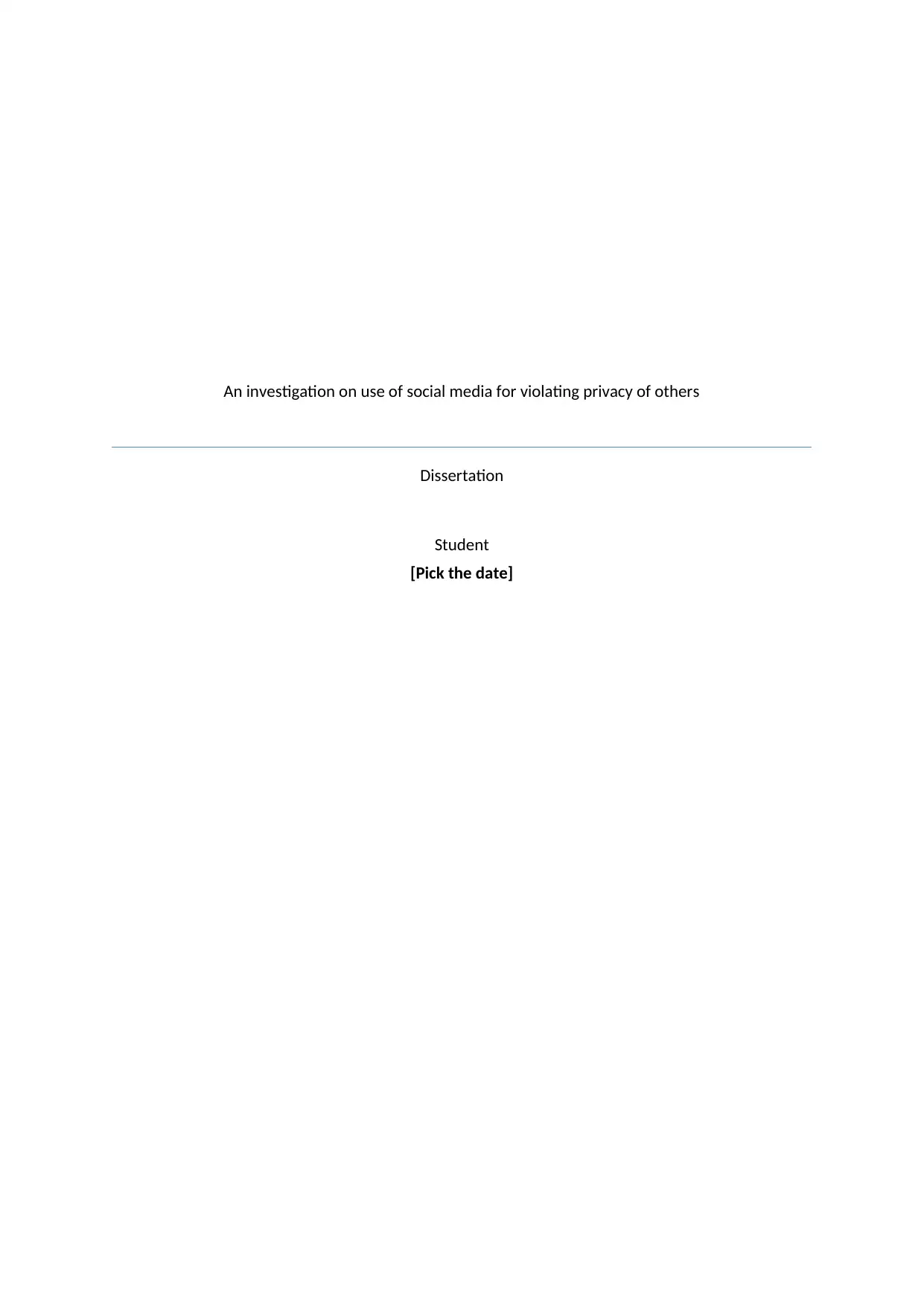
An investigation on use of social media for violating privacy of others
Dissertation
Student
[Pick the date]
Dissertation
Student
[Pick the date]
Paraphrase This Document
Need a fresh take? Get an instant paraphrase of this document with our AI Paraphraser
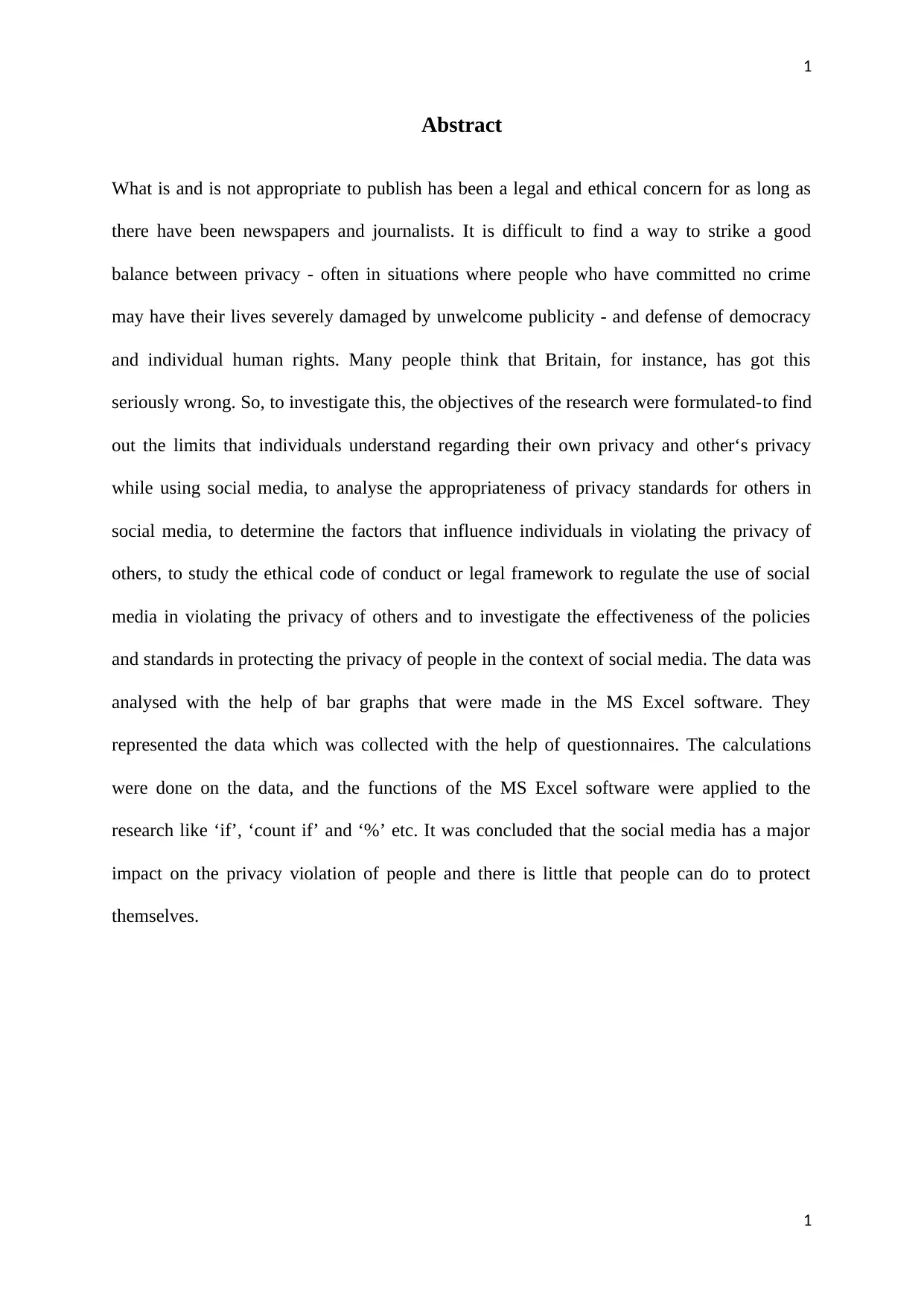
1
Abstract
What is and is not appropriate to publish has been a legal and ethical concern for as long as
there have been newspapers and journalists. It is difficult to find a way to strike a good
balance between privacy - often in situations where people who have committed no crime
may have their lives severely damaged by unwelcome publicity - and defense of democracy
and individual human rights. Many people think that Britain, for instance, has got this
seriously wrong. So, to investigate this, the objectives of the research were formulated-to find
out the limits that individuals understand regarding their own privacy and other‘s privacy
while using social media, to analyse the appropriateness of privacy standards for others in
social media, to determine the factors that influence individuals in violating the privacy of
others, to study the ethical code of conduct or legal framework to regulate the use of social
media in violating the privacy of others and to investigate the effectiveness of the policies
and standards in protecting the privacy of people in the context of social media. The data was
analysed with the help of bar graphs that were made in the MS Excel software. They
represented the data which was collected with the help of questionnaires. The calculations
were done on the data, and the functions of the MS Excel software were applied to the
research like ‘if’, ‘count if’ and ‘%’ etc. It was concluded that the social media has a major
impact on the privacy violation of people and there is little that people can do to protect
themselves.
1
Abstract
What is and is not appropriate to publish has been a legal and ethical concern for as long as
there have been newspapers and journalists. It is difficult to find a way to strike a good
balance between privacy - often in situations where people who have committed no crime
may have their lives severely damaged by unwelcome publicity - and defense of democracy
and individual human rights. Many people think that Britain, for instance, has got this
seriously wrong. So, to investigate this, the objectives of the research were formulated-to find
out the limits that individuals understand regarding their own privacy and other‘s privacy
while using social media, to analyse the appropriateness of privacy standards for others in
social media, to determine the factors that influence individuals in violating the privacy of
others, to study the ethical code of conduct or legal framework to regulate the use of social
media in violating the privacy of others and to investigate the effectiveness of the policies
and standards in protecting the privacy of people in the context of social media. The data was
analysed with the help of bar graphs that were made in the MS Excel software. They
represented the data which was collected with the help of questionnaires. The calculations
were done on the data, and the functions of the MS Excel software were applied to the
research like ‘if’, ‘count if’ and ‘%’ etc. It was concluded that the social media has a major
impact on the privacy violation of people and there is little that people can do to protect
themselves.
1
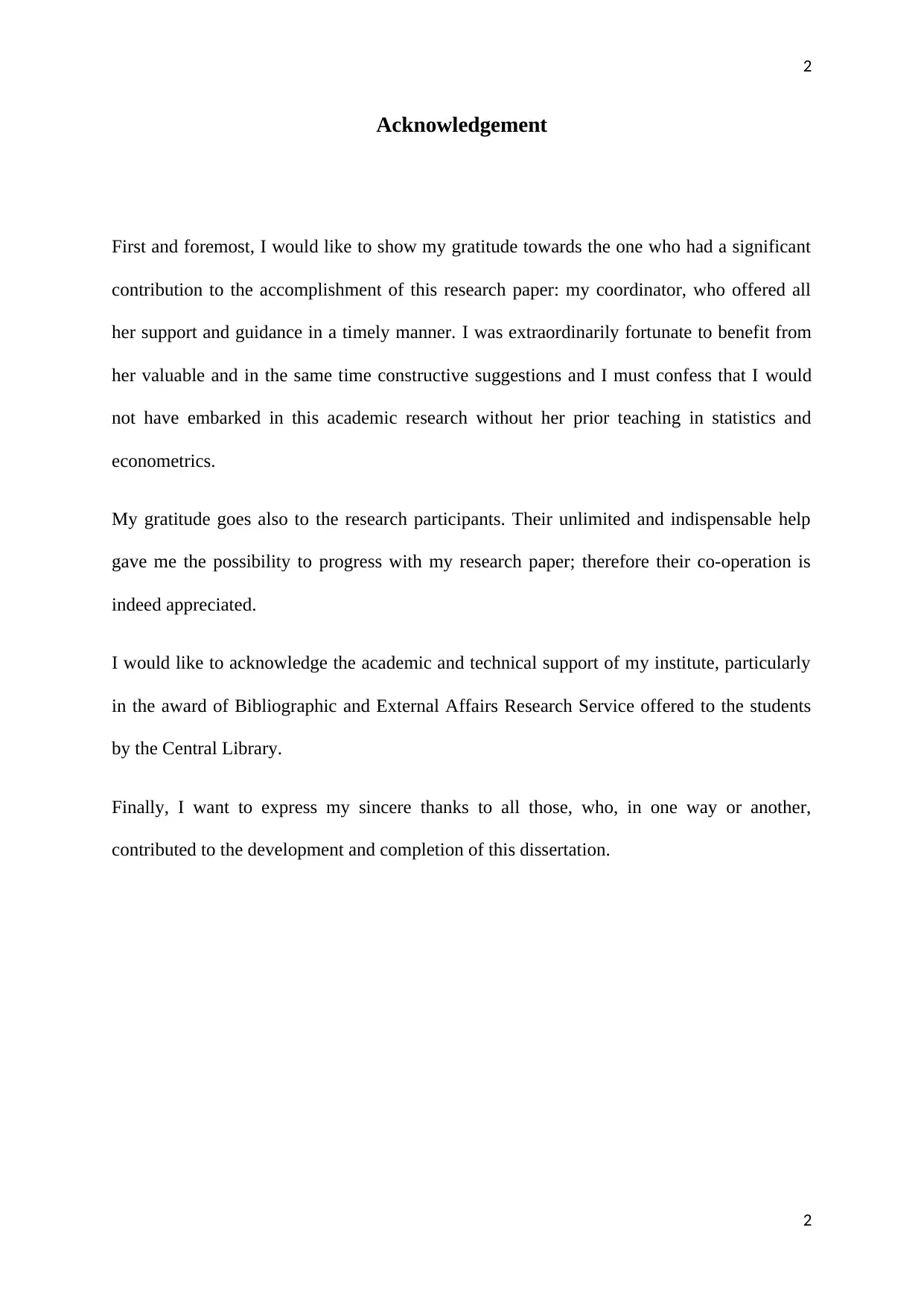
2
Acknowledgement
First and foremost, I would like to show my gratitude towards the one who had a significant
contribution to the accomplishment of this research paper: my coordinator, who offered all
her support and guidance in a timely manner. I was extraordinarily fortunate to benefit from
her valuable and in the same time constructive suggestions and I must confess that I would
not have embarked in this academic research without her prior teaching in statistics and
econometrics.
My gratitude goes also to the research participants. Their unlimited and indispensable help
gave me the possibility to progress with my research paper; therefore their co-operation is
indeed appreciated.
I would like to acknowledge the academic and technical support of my institute, particularly
in the award of Bibliographic and External Affairs Research Service offered to the students
by the Central Library.
Finally, I want to express my sincere thanks to all those, who, in one way or another,
contributed to the development and completion of this dissertation.
2
Acknowledgement
First and foremost, I would like to show my gratitude towards the one who had a significant
contribution to the accomplishment of this research paper: my coordinator, who offered all
her support and guidance in a timely manner. I was extraordinarily fortunate to benefit from
her valuable and in the same time constructive suggestions and I must confess that I would
not have embarked in this academic research without her prior teaching in statistics and
econometrics.
My gratitude goes also to the research participants. Their unlimited and indispensable help
gave me the possibility to progress with my research paper; therefore their co-operation is
indeed appreciated.
I would like to acknowledge the academic and technical support of my institute, particularly
in the award of Bibliographic and External Affairs Research Service offered to the students
by the Central Library.
Finally, I want to express my sincere thanks to all those, who, in one way or another,
contributed to the development and completion of this dissertation.
2
⊘ This is a preview!⊘
Do you want full access?
Subscribe today to unlock all pages.

Trusted by 1+ million students worldwide
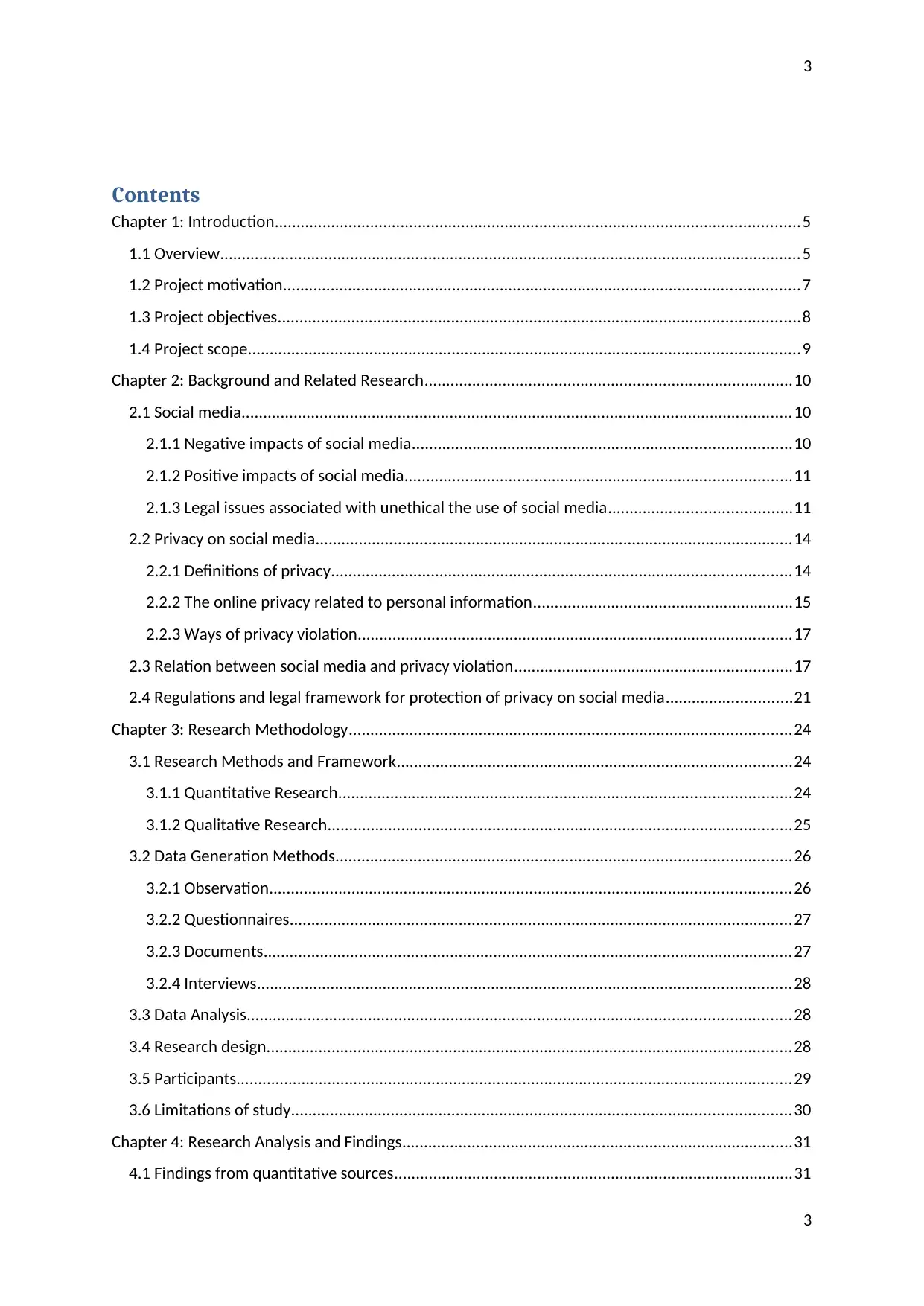
3
Contents
Chapter 1: Introduction.........................................................................................................................5
1.1 Overview......................................................................................................................................5
1.2 Project motivation.......................................................................................................................7
1.3 Project objectives........................................................................................................................8
1.4 Project scope...............................................................................................................................9
Chapter 2: Background and Related Research.....................................................................................10
2.1 Social media...............................................................................................................................10
2.1.1 Negative impacts of social media.......................................................................................10
2.1.2 Positive impacts of social media.........................................................................................11
2.1.3 Legal issues associated with unethical the use of social media..........................................11
2.2 Privacy on social media..............................................................................................................14
2.2.1 Definitions of privacy..........................................................................................................14
2.2.2 The online privacy related to personal information............................................................15
2.2.3 Ways of privacy violation....................................................................................................17
2.3 Relation between social media and privacy violation................................................................17
2.4 Regulations and legal framework for protection of privacy on social media.............................21
Chapter 3: Research Methodology......................................................................................................24
3.1 Research Methods and Framework...........................................................................................24
3.1.1 Quantitative Research........................................................................................................24
3.1.2 Qualitative Research...........................................................................................................25
3.2 Data Generation Methods.........................................................................................................26
3.2.1 Observation........................................................................................................................26
3.2.2 Questionnaires....................................................................................................................27
3.2.3 Documents..........................................................................................................................27
3.2.4 Interviews...........................................................................................................................28
3.3 Data Analysis.............................................................................................................................28
3.4 Research design.........................................................................................................................28
3.5 Participants................................................................................................................................29
3.6 Limitations of study...................................................................................................................30
Chapter 4: Research Analysis and Findings..........................................................................................31
4.1 Findings from quantitative sources............................................................................................31
3
Contents
Chapter 1: Introduction.........................................................................................................................5
1.1 Overview......................................................................................................................................5
1.2 Project motivation.......................................................................................................................7
1.3 Project objectives........................................................................................................................8
1.4 Project scope...............................................................................................................................9
Chapter 2: Background and Related Research.....................................................................................10
2.1 Social media...............................................................................................................................10
2.1.1 Negative impacts of social media.......................................................................................10
2.1.2 Positive impacts of social media.........................................................................................11
2.1.3 Legal issues associated with unethical the use of social media..........................................11
2.2 Privacy on social media..............................................................................................................14
2.2.1 Definitions of privacy..........................................................................................................14
2.2.2 The online privacy related to personal information............................................................15
2.2.3 Ways of privacy violation....................................................................................................17
2.3 Relation between social media and privacy violation................................................................17
2.4 Regulations and legal framework for protection of privacy on social media.............................21
Chapter 3: Research Methodology......................................................................................................24
3.1 Research Methods and Framework...........................................................................................24
3.1.1 Quantitative Research........................................................................................................24
3.1.2 Qualitative Research...........................................................................................................25
3.2 Data Generation Methods.........................................................................................................26
3.2.1 Observation........................................................................................................................26
3.2.2 Questionnaires....................................................................................................................27
3.2.3 Documents..........................................................................................................................27
3.2.4 Interviews...........................................................................................................................28
3.3 Data Analysis.............................................................................................................................28
3.4 Research design.........................................................................................................................28
3.5 Participants................................................................................................................................29
3.6 Limitations of study...................................................................................................................30
Chapter 4: Research Analysis and Findings..........................................................................................31
4.1 Findings from quantitative sources............................................................................................31
3
Paraphrase This Document
Need a fresh take? Get an instant paraphrase of this document with our AI Paraphraser
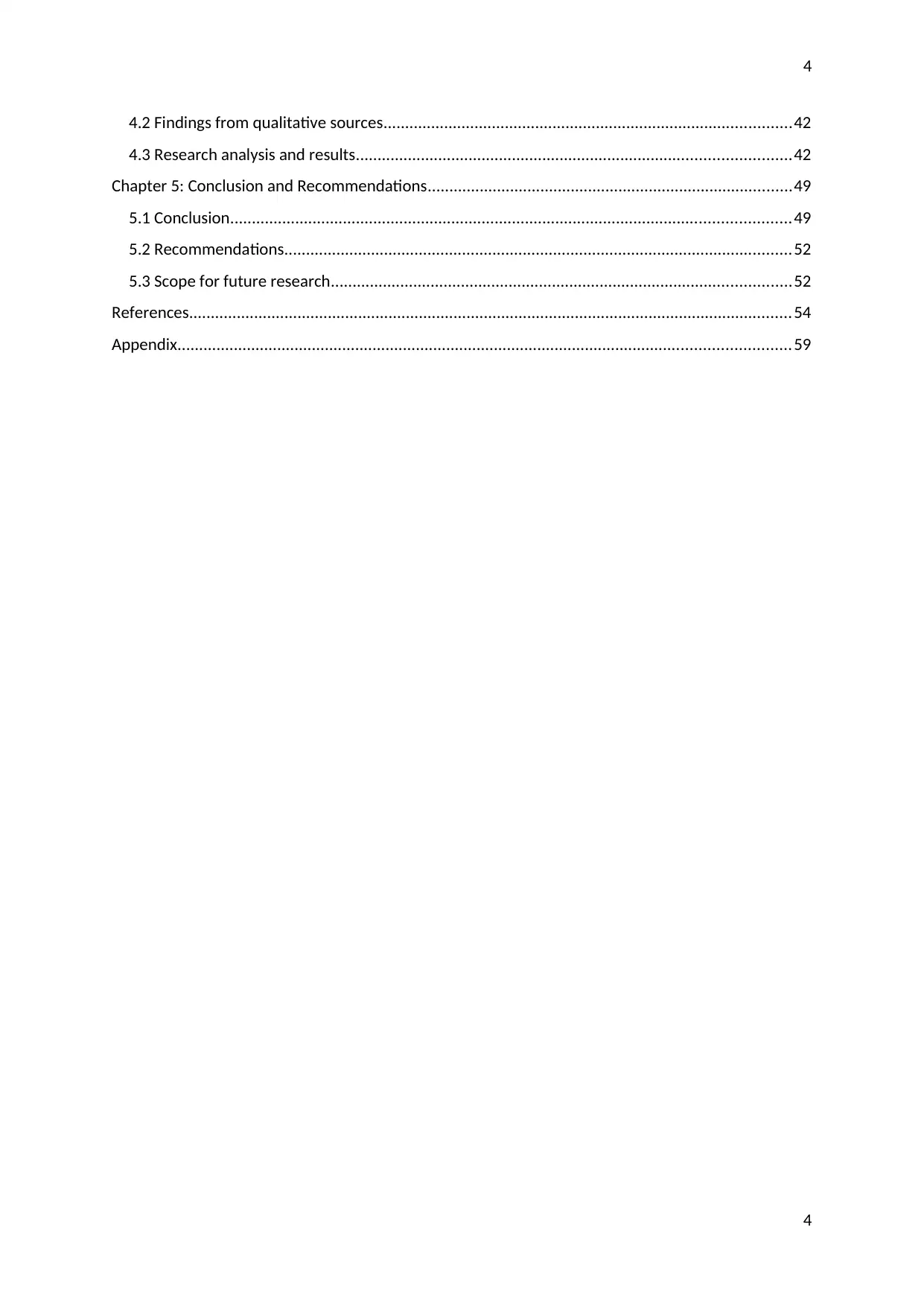
4
4.2 Findings from qualitative sources..............................................................................................42
4.3 Research analysis and results....................................................................................................42
Chapter 5: Conclusion and Recommendations....................................................................................49
5.1 Conclusion.................................................................................................................................49
5.2 Recommendations.....................................................................................................................52
5.3 Scope for future research..........................................................................................................52
References...........................................................................................................................................54
Appendix.............................................................................................................................................59
4
4.2 Findings from qualitative sources..............................................................................................42
4.3 Research analysis and results....................................................................................................42
Chapter 5: Conclusion and Recommendations....................................................................................49
5.1 Conclusion.................................................................................................................................49
5.2 Recommendations.....................................................................................................................52
5.3 Scope for future research..........................................................................................................52
References...........................................................................................................................................54
Appendix.............................................................................................................................................59
4
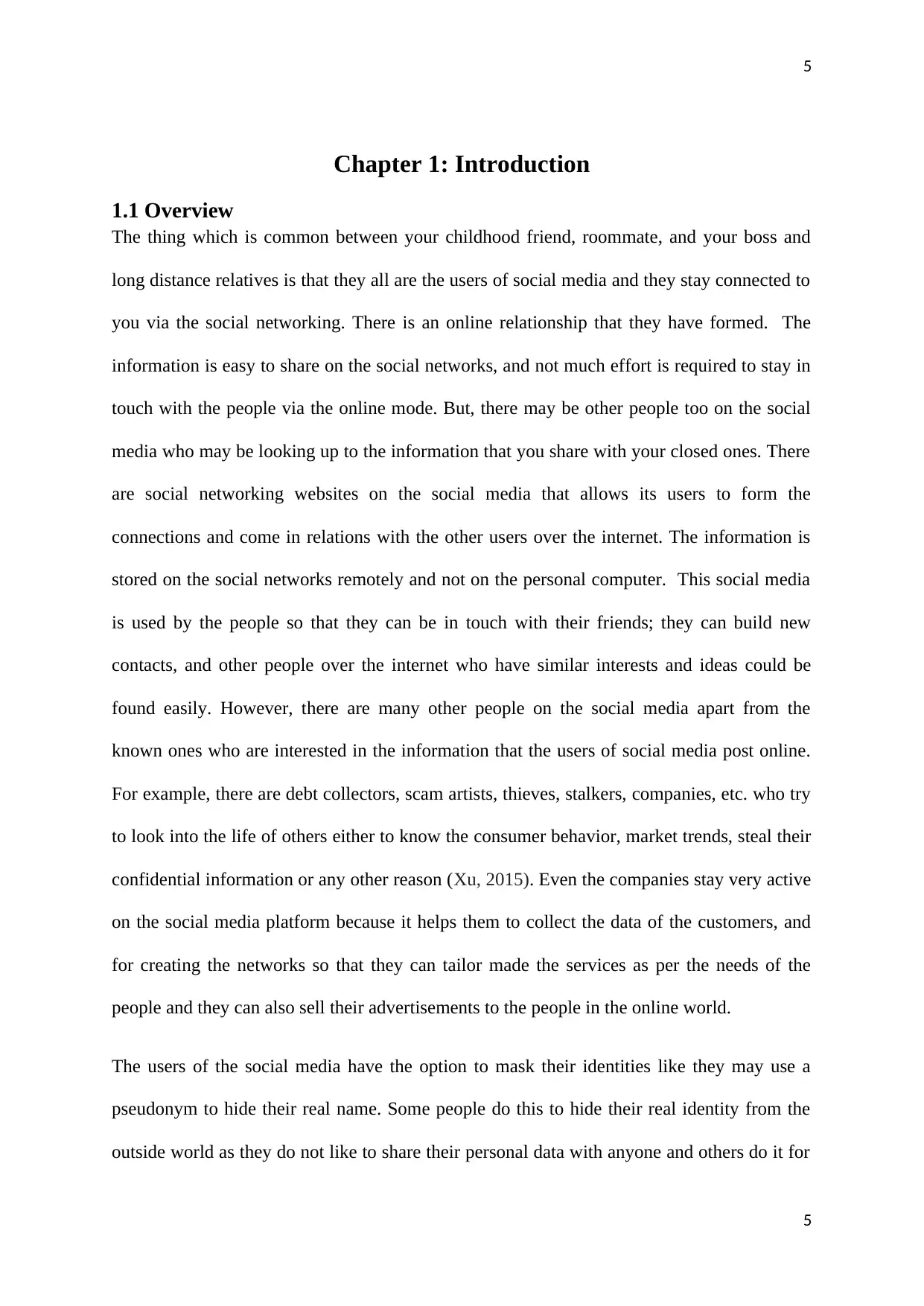
5
Chapter 1: Introduction
1.1 Overview
The thing which is common between your childhood friend, roommate, and your boss and
long distance relatives is that they all are the users of social media and they stay connected to
you via the social networking. There is an online relationship that they have formed. The
information is easy to share on the social networks, and not much effort is required to stay in
touch with the people via the online mode. But, there may be other people too on the social
media who may be looking up to the information that you share with your closed ones. There
are social networking websites on the social media that allows its users to form the
connections and come in relations with the other users over the internet. The information is
stored on the social networks remotely and not on the personal computer. This social media
is used by the people so that they can be in touch with their friends; they can build new
contacts, and other people over the internet who have similar interests and ideas could be
found easily. However, there are many other people on the social media apart from the
known ones who are interested in the information that the users of social media post online.
For example, there are debt collectors, scam artists, thieves, stalkers, companies, etc. who try
to look into the life of others either to know the consumer behavior, market trends, steal their
confidential information or any other reason (Xu, 2015). Even the companies stay very active
on the social media platform because it helps them to collect the data of the customers, and
for creating the networks so that they can tailor made the services as per the needs of the
people and they can also sell their advertisements to the people in the online world.
The users of the social media have the option to mask their identities like they may use a
pseudonym to hide their real name. Some people do this to hide their real identity from the
outside world as they do not like to share their personal data with anyone and others do it for
5
Chapter 1: Introduction
1.1 Overview
The thing which is common between your childhood friend, roommate, and your boss and
long distance relatives is that they all are the users of social media and they stay connected to
you via the social networking. There is an online relationship that they have formed. The
information is easy to share on the social networks, and not much effort is required to stay in
touch with the people via the online mode. But, there may be other people too on the social
media who may be looking up to the information that you share with your closed ones. There
are social networking websites on the social media that allows its users to form the
connections and come in relations with the other users over the internet. The information is
stored on the social networks remotely and not on the personal computer. This social media
is used by the people so that they can be in touch with their friends; they can build new
contacts, and other people over the internet who have similar interests and ideas could be
found easily. However, there are many other people on the social media apart from the
known ones who are interested in the information that the users of social media post online.
For example, there are debt collectors, scam artists, thieves, stalkers, companies, etc. who try
to look into the life of others either to know the consumer behavior, market trends, steal their
confidential information or any other reason (Xu, 2015). Even the companies stay very active
on the social media platform because it helps them to collect the data of the customers, and
for creating the networks so that they can tailor made the services as per the needs of the
people and they can also sell their advertisements to the people in the online world.
The users of the social media have the option to mask their identities like they may use a
pseudonym to hide their real name. Some people do this to hide their real identity from the
outside world as they do not like to share their personal data with anyone and others do it for
5
⊘ This is a preview!⊘
Do you want full access?
Subscribe today to unlock all pages.

Trusted by 1+ million students worldwide
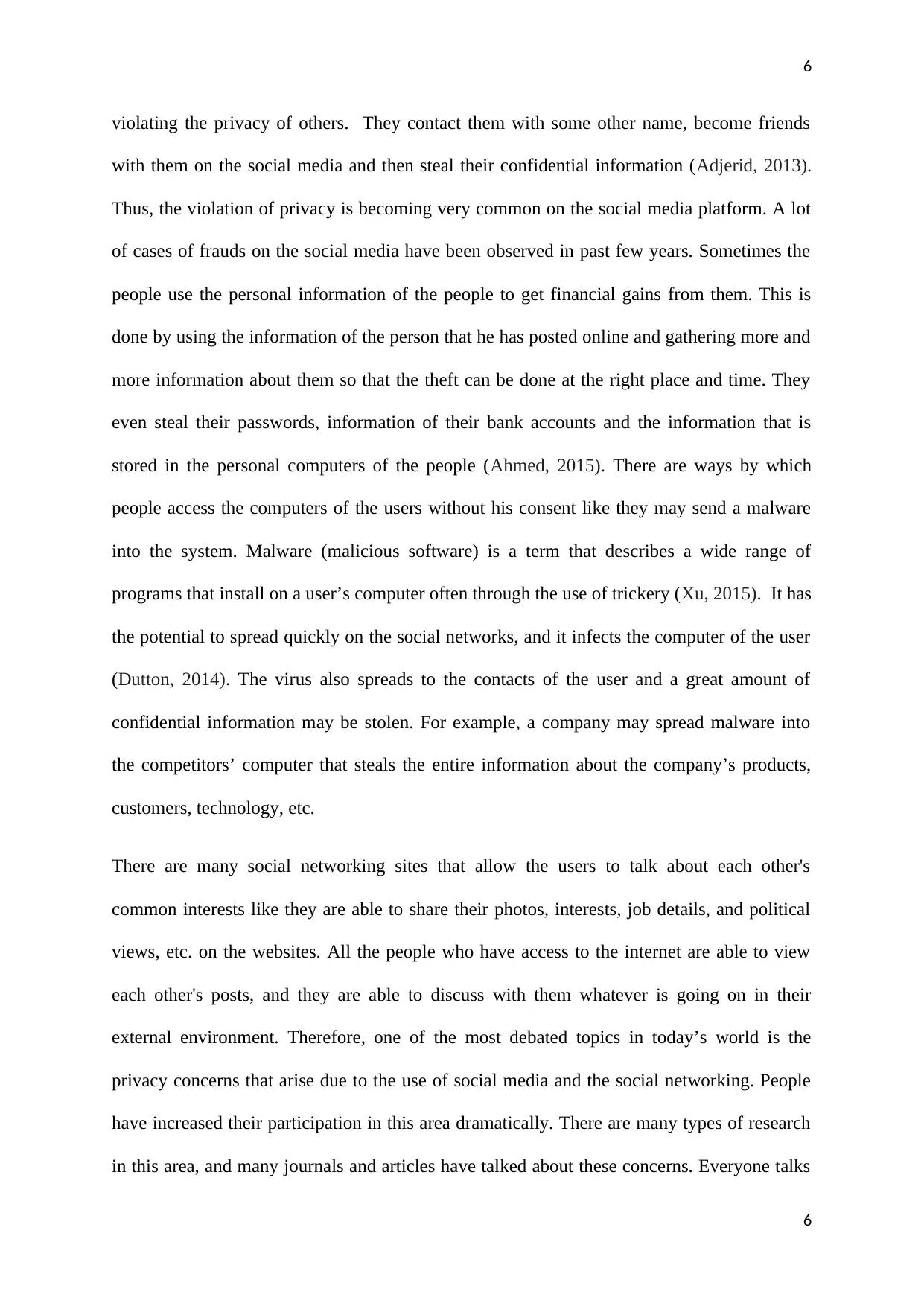
6
violating the privacy of others. They contact them with some other name, become friends
with them on the social media and then steal their confidential information (Adjerid, 2013).
Thus, the violation of privacy is becoming very common on the social media platform. A lot
of cases of frauds on the social media have been observed in past few years. Sometimes the
people use the personal information of the people to get financial gains from them. This is
done by using the information of the person that he has posted online and gathering more and
more information about them so that the theft can be done at the right place and time. They
even steal their passwords, information of their bank accounts and the information that is
stored in the personal computers of the people (Ahmed, 2015). There are ways by which
people access the computers of the users without his consent like they may send a malware
into the system. Malware (malicious software) is a term that describes a wide range of
programs that install on a user’s computer often through the use of trickery (Xu, 2015). It has
the potential to spread quickly on the social networks, and it infects the computer of the user
(Dutton, 2014). The virus also spreads to the contacts of the user and a great amount of
confidential information may be stolen. For example, a company may spread malware into
the competitors’ computer that steals the entire information about the company’s products,
customers, technology, etc.
There are many social networking sites that allow the users to talk about each other's
common interests like they are able to share their photos, interests, job details, and political
views, etc. on the websites. All the people who have access to the internet are able to view
each other's posts, and they are able to discuss with them whatever is going on in their
external environment. Therefore, one of the most debated topics in today’s world is the
privacy concerns that arise due to the use of social media and the social networking. People
have increased their participation in this area dramatically. There are many types of research
in this area, and many journals and articles have talked about these concerns. Everyone talks
6
violating the privacy of others. They contact them with some other name, become friends
with them on the social media and then steal their confidential information (Adjerid, 2013).
Thus, the violation of privacy is becoming very common on the social media platform. A lot
of cases of frauds on the social media have been observed in past few years. Sometimes the
people use the personal information of the people to get financial gains from them. This is
done by using the information of the person that he has posted online and gathering more and
more information about them so that the theft can be done at the right place and time. They
even steal their passwords, information of their bank accounts and the information that is
stored in the personal computers of the people (Ahmed, 2015). There are ways by which
people access the computers of the users without his consent like they may send a malware
into the system. Malware (malicious software) is a term that describes a wide range of
programs that install on a user’s computer often through the use of trickery (Xu, 2015). It has
the potential to spread quickly on the social networks, and it infects the computer of the user
(Dutton, 2014). The virus also spreads to the contacts of the user and a great amount of
confidential information may be stolen. For example, a company may spread malware into
the competitors’ computer that steals the entire information about the company’s products,
customers, technology, etc.
There are many social networking sites that allow the users to talk about each other's
common interests like they are able to share their photos, interests, job details, and political
views, etc. on the websites. All the people who have access to the internet are able to view
each other's posts, and they are able to discuss with them whatever is going on in their
external environment. Therefore, one of the most debated topics in today’s world is the
privacy concerns that arise due to the use of social media and the social networking. People
have increased their participation in this area dramatically. There are many types of research
in this area, and many journals and articles have talked about these concerns. Everyone talks
6
Paraphrase This Document
Need a fresh take? Get an instant paraphrase of this document with our AI Paraphraser
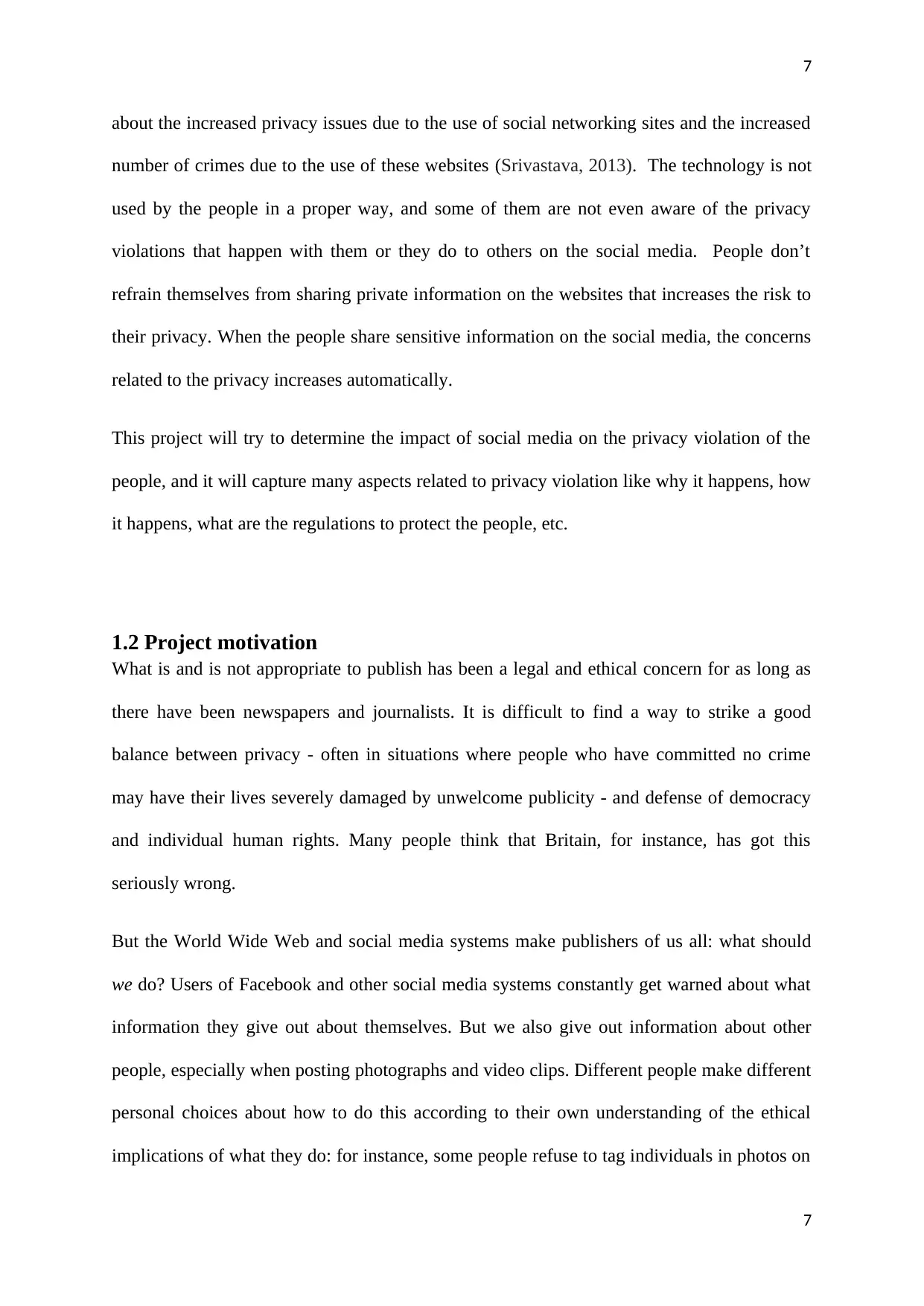
7
about the increased privacy issues due to the use of social networking sites and the increased
number of crimes due to the use of these websites (Srivastava, 2013). The technology is not
used by the people in a proper way, and some of them are not even aware of the privacy
violations that happen with them or they do to others on the social media. People don’t
refrain themselves from sharing private information on the websites that increases the risk to
their privacy. When the people share sensitive information on the social media, the concerns
related to the privacy increases automatically.
This project will try to determine the impact of social media on the privacy violation of the
people, and it will capture many aspects related to privacy violation like why it happens, how
it happens, what are the regulations to protect the people, etc.
1.2 Project motivation
What is and is not appropriate to publish has been a legal and ethical concern for as long as
there have been newspapers and journalists. It is difficult to find a way to strike a good
balance between privacy - often in situations where people who have committed no crime
may have their lives severely damaged by unwelcome publicity - and defense of democracy
and individual human rights. Many people think that Britain, for instance, has got this
seriously wrong.
But the World Wide Web and social media systems make publishers of us all: what should
we do? Users of Facebook and other social media systems constantly get warned about what
information they give out about themselves. But we also give out information about other
people, especially when posting photographs and video clips. Different people make different
personal choices about how to do this according to their own understanding of the ethical
implications of what they do: for instance, some people refuse to tag individuals in photos on
7
about the increased privacy issues due to the use of social networking sites and the increased
number of crimes due to the use of these websites (Srivastava, 2013). The technology is not
used by the people in a proper way, and some of them are not even aware of the privacy
violations that happen with them or they do to others on the social media. People don’t
refrain themselves from sharing private information on the websites that increases the risk to
their privacy. When the people share sensitive information on the social media, the concerns
related to the privacy increases automatically.
This project will try to determine the impact of social media on the privacy violation of the
people, and it will capture many aspects related to privacy violation like why it happens, how
it happens, what are the regulations to protect the people, etc.
1.2 Project motivation
What is and is not appropriate to publish has been a legal and ethical concern for as long as
there have been newspapers and journalists. It is difficult to find a way to strike a good
balance between privacy - often in situations where people who have committed no crime
may have their lives severely damaged by unwelcome publicity - and defense of democracy
and individual human rights. Many people think that Britain, for instance, has got this
seriously wrong.
But the World Wide Web and social media systems make publishers of us all: what should
we do? Users of Facebook and other social media systems constantly get warned about what
information they give out about themselves. But we also give out information about other
people, especially when posting photographs and video clips. Different people make different
personal choices about how to do this according to their own understanding of the ethical
implications of what they do: for instance, some people refuse to tag individuals in photos on
7
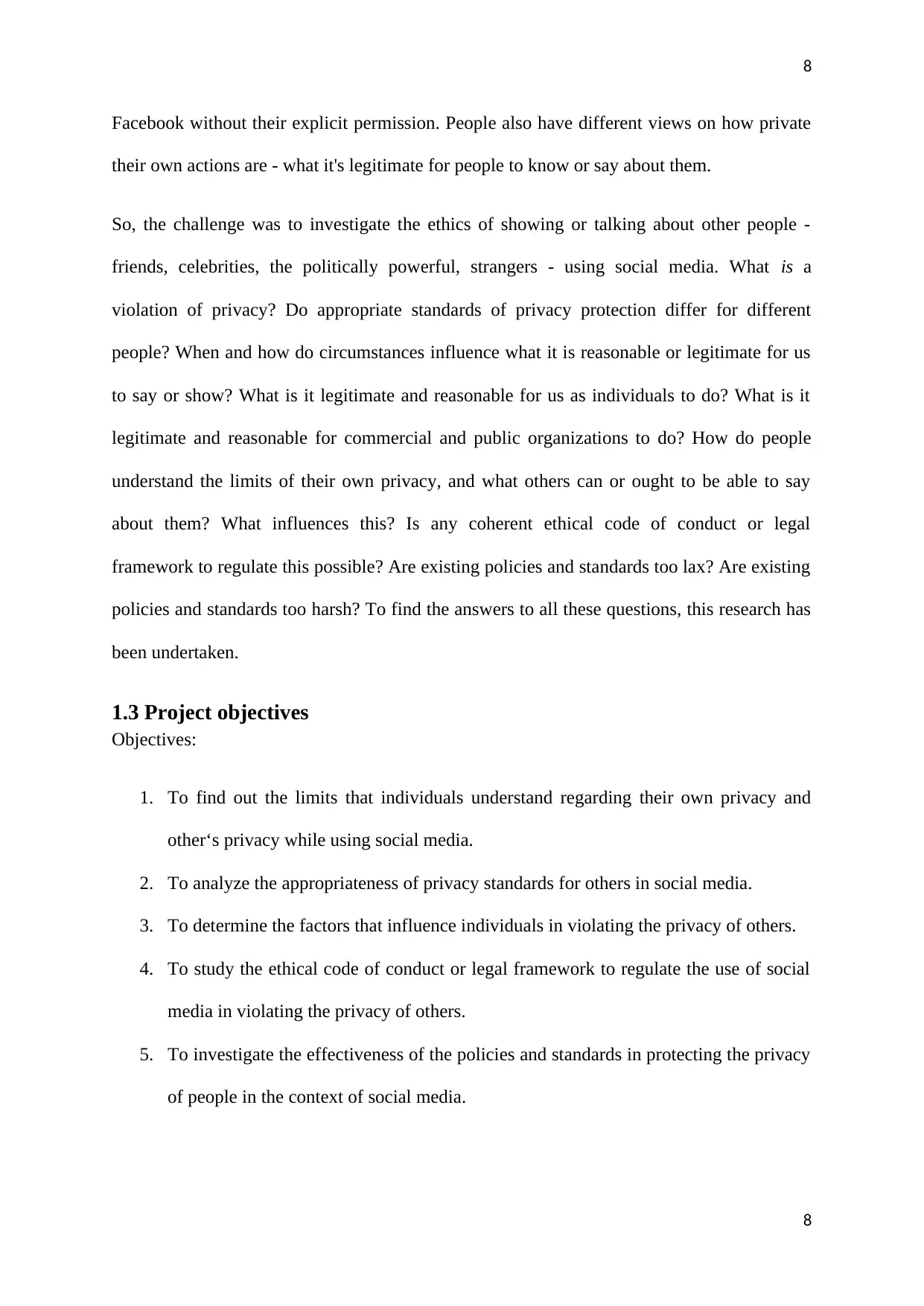
8
Facebook without their explicit permission. People also have different views on how private
their own actions are - what it's legitimate for people to know or say about them.
So, the challenge was to investigate the ethics of showing or talking about other people -
friends, celebrities, the politically powerful, strangers - using social media. What is a
violation of privacy? Do appropriate standards of privacy protection differ for different
people? When and how do circumstances influence what it is reasonable or legitimate for us
to say or show? What is it legitimate and reasonable for us as individuals to do? What is it
legitimate and reasonable for commercial and public organizations to do? How do people
understand the limits of their own privacy, and what others can or ought to be able to say
about them? What influences this? Is any coherent ethical code of conduct or legal
framework to regulate this possible? Are existing policies and standards too lax? Are existing
policies and standards too harsh? To find the answers to all these questions, this research has
been undertaken.
1.3 Project objectives
Objectives:
1. To find out the limits that individuals understand regarding their own privacy and
other‘s privacy while using social media.
2. To analyze the appropriateness of privacy standards for others in social media.
3. To determine the factors that influence individuals in violating the privacy of others.
4. To study the ethical code of conduct or legal framework to regulate the use of social
media in violating the privacy of others.
5. To investigate the effectiveness of the policies and standards in protecting the privacy
of people in the context of social media.
8
Facebook without their explicit permission. People also have different views on how private
their own actions are - what it's legitimate for people to know or say about them.
So, the challenge was to investigate the ethics of showing or talking about other people -
friends, celebrities, the politically powerful, strangers - using social media. What is a
violation of privacy? Do appropriate standards of privacy protection differ for different
people? When and how do circumstances influence what it is reasonable or legitimate for us
to say or show? What is it legitimate and reasonable for us as individuals to do? What is it
legitimate and reasonable for commercial and public organizations to do? How do people
understand the limits of their own privacy, and what others can or ought to be able to say
about them? What influences this? Is any coherent ethical code of conduct or legal
framework to regulate this possible? Are existing policies and standards too lax? Are existing
policies and standards too harsh? To find the answers to all these questions, this research has
been undertaken.
1.3 Project objectives
Objectives:
1. To find out the limits that individuals understand regarding their own privacy and
other‘s privacy while using social media.
2. To analyze the appropriateness of privacy standards for others in social media.
3. To determine the factors that influence individuals in violating the privacy of others.
4. To study the ethical code of conduct or legal framework to regulate the use of social
media in violating the privacy of others.
5. To investigate the effectiveness of the policies and standards in protecting the privacy
of people in the context of social media.
8
⊘ This is a preview!⊘
Do you want full access?
Subscribe today to unlock all pages.

Trusted by 1+ million students worldwide
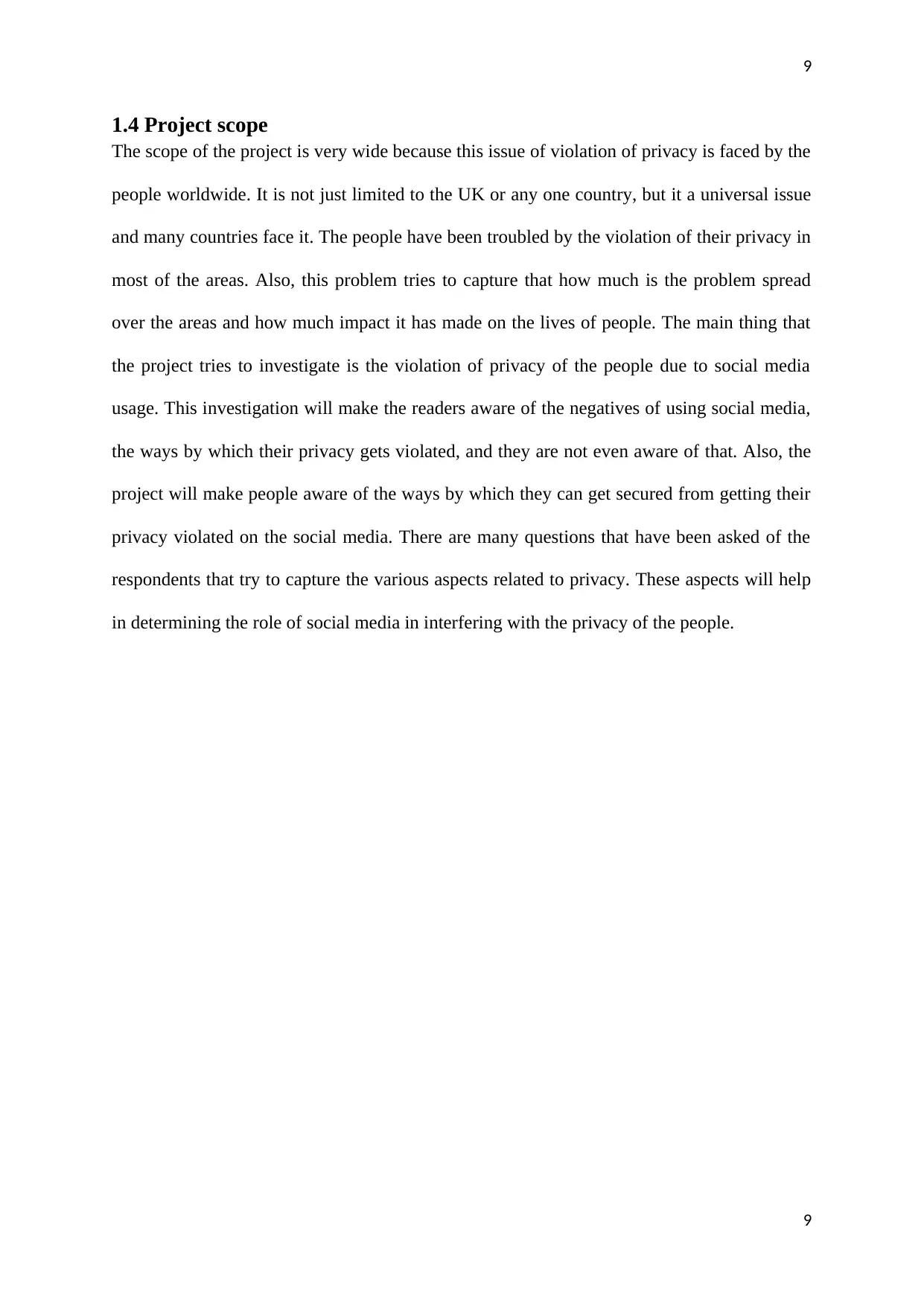
9
1.4 Project scope
The scope of the project is very wide because this issue of violation of privacy is faced by the
people worldwide. It is not just limited to the UK or any one country, but it a universal issue
and many countries face it. The people have been troubled by the violation of their privacy in
most of the areas. Also, this problem tries to capture that how much is the problem spread
over the areas and how much impact it has made on the lives of people. The main thing that
the project tries to investigate is the violation of privacy of the people due to social media
usage. This investigation will make the readers aware of the negatives of using social media,
the ways by which their privacy gets violated, and they are not even aware of that. Also, the
project will make people aware of the ways by which they can get secured from getting their
privacy violated on the social media. There are many questions that have been asked of the
respondents that try to capture the various aspects related to privacy. These aspects will help
in determining the role of social media in interfering with the privacy of the people.
9
1.4 Project scope
The scope of the project is very wide because this issue of violation of privacy is faced by the
people worldwide. It is not just limited to the UK or any one country, but it a universal issue
and many countries face it. The people have been troubled by the violation of their privacy in
most of the areas. Also, this problem tries to capture that how much is the problem spread
over the areas and how much impact it has made on the lives of people. The main thing that
the project tries to investigate is the violation of privacy of the people due to social media
usage. This investigation will make the readers aware of the negatives of using social media,
the ways by which their privacy gets violated, and they are not even aware of that. Also, the
project will make people aware of the ways by which they can get secured from getting their
privacy violated on the social media. There are many questions that have been asked of the
respondents that try to capture the various aspects related to privacy. These aspects will help
in determining the role of social media in interfering with the privacy of the people.
9
Paraphrase This Document
Need a fresh take? Get an instant paraphrase of this document with our AI Paraphraser
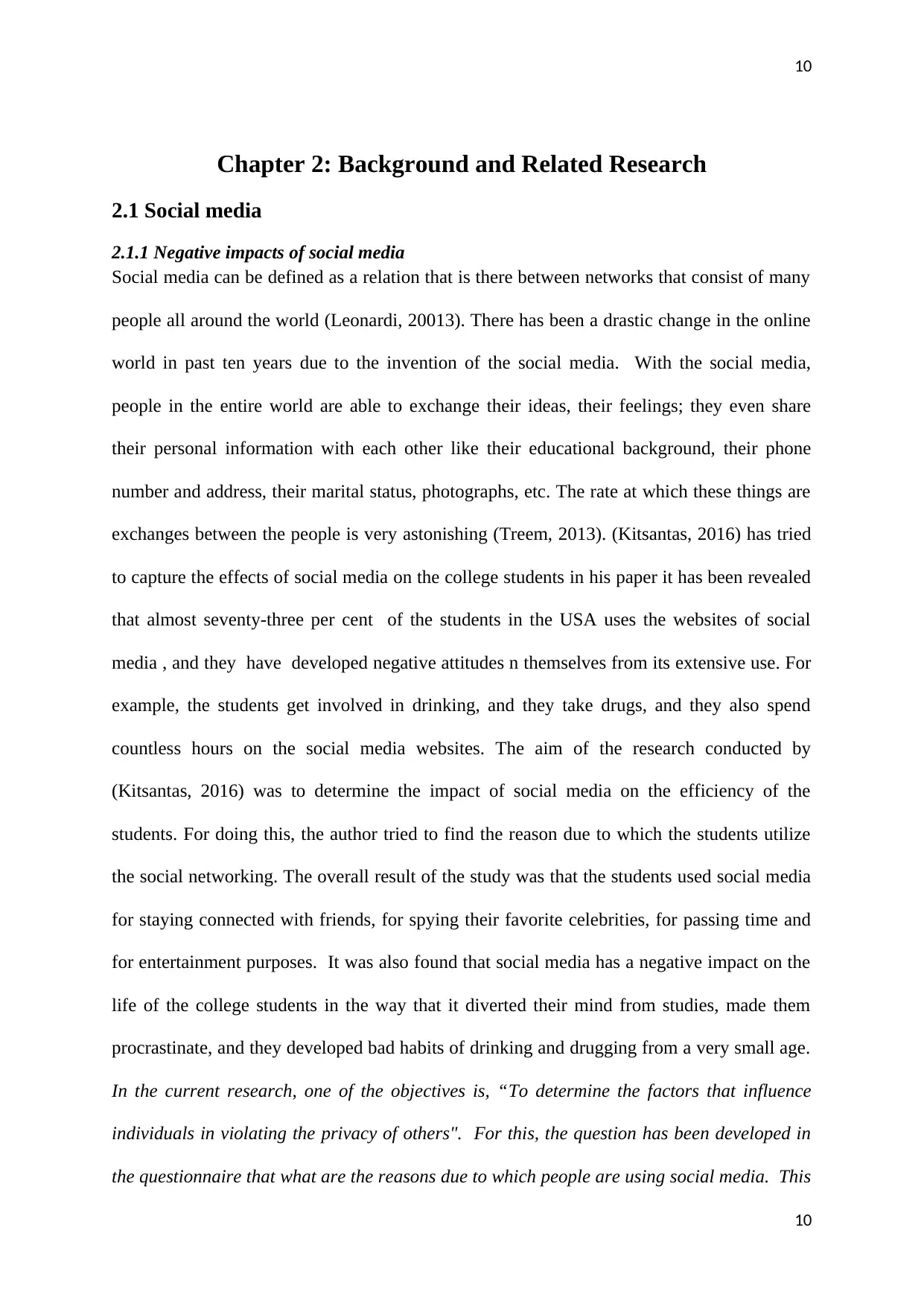
10
Chapter 2: Background and Related Research
2.1 Social media
2.1.1 Negative impacts of social media
Social media can be defined as a relation that is there between networks that consist of many
people all around the world (Leonardi, 20013). There has been a drastic change in the online
world in past ten years due to the invention of the social media. With the social media,
people in the entire world are able to exchange their ideas, their feelings; they even share
their personal information with each other like their educational background, their phone
number and address, their marital status, photographs, etc. The rate at which these things are
exchanges between the people is very astonishing (Treem, 2013). (Kitsantas, 2016) has tried
to capture the effects of social media on the college students in his paper it has been revealed
that almost seventy-three per cent of the students in the USA uses the websites of social
media , and they have developed negative attitudes n themselves from its extensive use. For
example, the students get involved in drinking, and they take drugs, and they also spend
countless hours on the social media websites. The aim of the research conducted by
(Kitsantas, 2016) was to determine the impact of social media on the efficiency of the
students. For doing this, the author tried to find the reason due to which the students utilize
the social networking. The overall result of the study was that the students used social media
for staying connected with friends, for spying their favorite celebrities, for passing time and
for entertainment purposes. It was also found that social media has a negative impact on the
life of the college students in the way that it diverted their mind from studies, made them
procrastinate, and they developed bad habits of drinking and drugging from a very small age.
In the current research, one of the objectives is, “To determine the factors that influence
individuals in violating the privacy of others". For this, the question has been developed in
the questionnaire that what are the reasons due to which people are using social media. This
10
Chapter 2: Background and Related Research
2.1 Social media
2.1.1 Negative impacts of social media
Social media can be defined as a relation that is there between networks that consist of many
people all around the world (Leonardi, 20013). There has been a drastic change in the online
world in past ten years due to the invention of the social media. With the social media,
people in the entire world are able to exchange their ideas, their feelings; they even share
their personal information with each other like their educational background, their phone
number and address, their marital status, photographs, etc. The rate at which these things are
exchanges between the people is very astonishing (Treem, 2013). (Kitsantas, 2016) has tried
to capture the effects of social media on the college students in his paper it has been revealed
that almost seventy-three per cent of the students in the USA uses the websites of social
media , and they have developed negative attitudes n themselves from its extensive use. For
example, the students get involved in drinking, and they take drugs, and they also spend
countless hours on the social media websites. The aim of the research conducted by
(Kitsantas, 2016) was to determine the impact of social media on the efficiency of the
students. For doing this, the author tried to find the reason due to which the students utilize
the social networking. The overall result of the study was that the students used social media
for staying connected with friends, for spying their favorite celebrities, for passing time and
for entertainment purposes. It was also found that social media has a negative impact on the
life of the college students in the way that it diverted their mind from studies, made them
procrastinate, and they developed bad habits of drinking and drugging from a very small age.
In the current research, one of the objectives is, “To determine the factors that influence
individuals in violating the privacy of others". For this, the question has been developed in
the questionnaire that what are the reasons due to which people are using social media. This
10
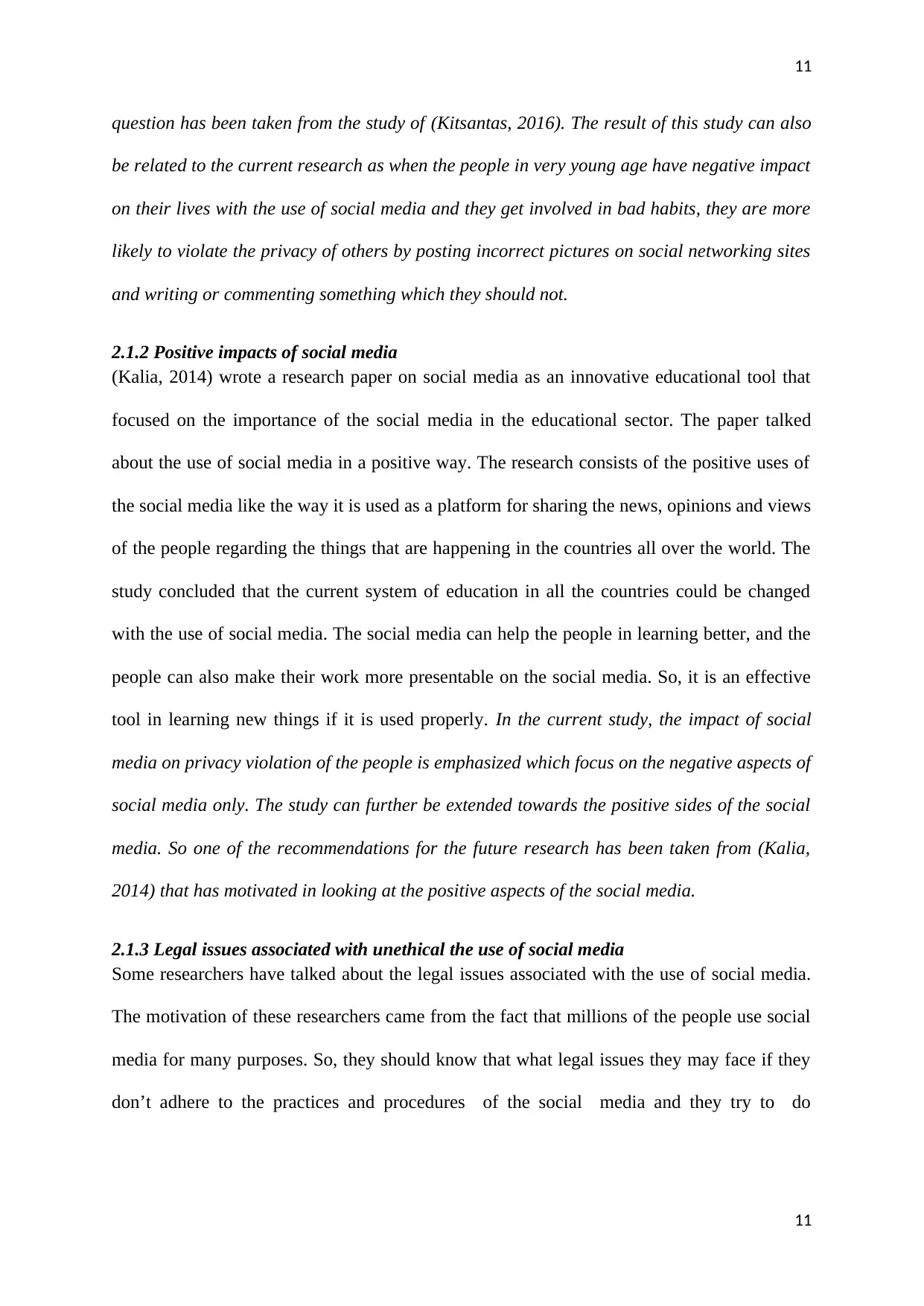
11
question has been taken from the study of (Kitsantas, 2016). The result of this study can also
be related to the current research as when the people in very young age have negative impact
on their lives with the use of social media and they get involved in bad habits, they are more
likely to violate the privacy of others by posting incorrect pictures on social networking sites
and writing or commenting something which they should not.
2.1.2 Positive impacts of social media
(Kalia, 2014) wrote a research paper on social media as an innovative educational tool that
focused on the importance of the social media in the educational sector. The paper talked
about the use of social media in a positive way. The research consists of the positive uses of
the social media like the way it is used as a platform for sharing the news, opinions and views
of the people regarding the things that are happening in the countries all over the world. The
study concluded that the current system of education in all the countries could be changed
with the use of social media. The social media can help the people in learning better, and the
people can also make their work more presentable on the social media. So, it is an effective
tool in learning new things if it is used properly. In the current study, the impact of social
media on privacy violation of the people is emphasized which focus on the negative aspects of
social media only. The study can further be extended towards the positive sides of the social
media. So one of the recommendations for the future research has been taken from (Kalia,
2014) that has motivated in looking at the positive aspects of the social media.
2.1.3 Legal issues associated with unethical the use of social media
Some researchers have talked about the legal issues associated with the use of social media.
The motivation of these researchers came from the fact that millions of the people use social
media for many purposes. So, they should know that what legal issues they may face if they
don’t adhere to the practices and procedures of the social media and they try to do
11
question has been taken from the study of (Kitsantas, 2016). The result of this study can also
be related to the current research as when the people in very young age have negative impact
on their lives with the use of social media and they get involved in bad habits, they are more
likely to violate the privacy of others by posting incorrect pictures on social networking sites
and writing or commenting something which they should not.
2.1.2 Positive impacts of social media
(Kalia, 2014) wrote a research paper on social media as an innovative educational tool that
focused on the importance of the social media in the educational sector. The paper talked
about the use of social media in a positive way. The research consists of the positive uses of
the social media like the way it is used as a platform for sharing the news, opinions and views
of the people regarding the things that are happening in the countries all over the world. The
study concluded that the current system of education in all the countries could be changed
with the use of social media. The social media can help the people in learning better, and the
people can also make their work more presentable on the social media. So, it is an effective
tool in learning new things if it is used properly. In the current study, the impact of social
media on privacy violation of the people is emphasized which focus on the negative aspects of
social media only. The study can further be extended towards the positive sides of the social
media. So one of the recommendations for the future research has been taken from (Kalia,
2014) that has motivated in looking at the positive aspects of the social media.
2.1.3 Legal issues associated with unethical the use of social media
Some researchers have talked about the legal issues associated with the use of social media.
The motivation of these researchers came from the fact that millions of the people use social
media for many purposes. So, they should know that what legal issues they may face if they
don’t adhere to the practices and procedures of the social media and they try to do
11
⊘ This is a preview!⊘
Do you want full access?
Subscribe today to unlock all pages.

Trusted by 1+ million students worldwide
1 out of 64
Related Documents
Your All-in-One AI-Powered Toolkit for Academic Success.
+13062052269
info@desklib.com
Available 24*7 on WhatsApp / Email
![[object Object]](/_next/static/media/star-bottom.7253800d.svg)
Unlock your academic potential
Copyright © 2020–2025 A2Z Services. All Rights Reserved. Developed and managed by ZUCOL.





